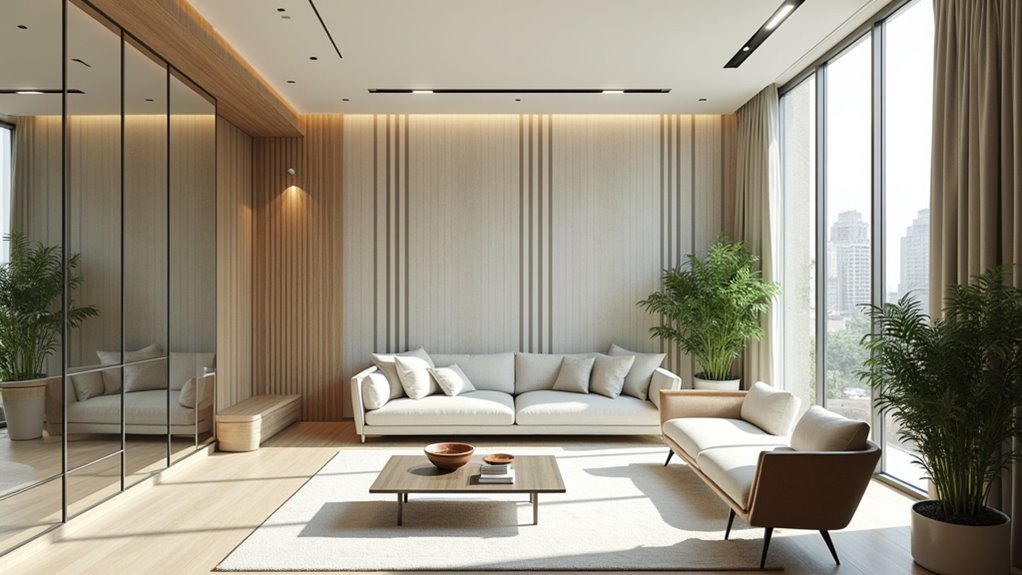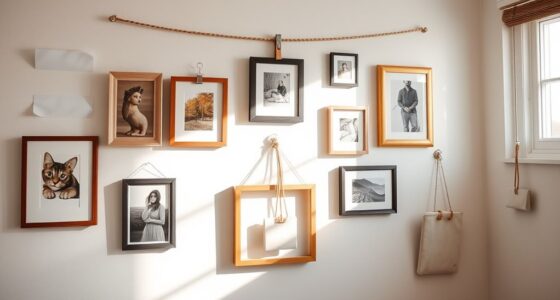To make a small room look bigger, you’ll want to use light paint colors that reflect light and create an airy feel. Arrange your furniture away from walls for a more open layout and choose multi-functional pieces to optimize space. Reducing clutter is essential for a serene environment, while adding mirrors can create an illusion of depth. Finally, emphasize vertical space with tall bookshelves or artwork. Discover more designer tricks to enhance your space even further!
Key Takeaways
- Use light paint colors and a monochromatic scheme to create a cohesive and airy feel that enhances the illusion of space.
- Arrange furniture away from walls to promote openness and ensure clear pathways for movement throughout the room.
- Incorporate mirrors strategically to reflect light and create a sense of depth, making the space appear larger.
- Utilize vertical storage solutions and decor to draw the eye upward, emphasizing ceiling height and spaciousness.
- Limit clutter and decorative accents, maintaining a clean and organized look that fosters a serene environment.
Use Light Paint Colors
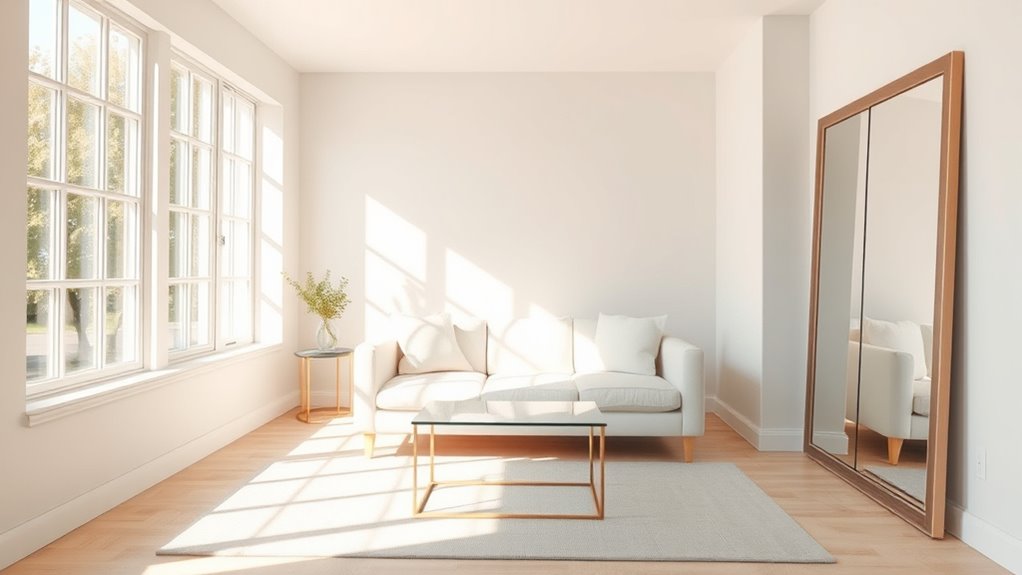
When you want to make a small room feel larger, using light paint colors is a game-changer. Shades like warm off-white and soft pastels reflect light, creating a brighter and more spacious appearance.
By painting your walls, ceilings, and trims in a single light color, you blur boundaries, enhancing the illusion of height and making the space seem more expansive. Lighter shades also maintain a fresh and airy ambiance, avoiding a sterile look while inviting warmth. Additionally, light colors can help to create a calming environment, which can further contribute to the perception of space. Incorporating lighting design can enhance this effect, making the room feel even more open and inviting. Furthermore, utilizing innovative interior design strategies can transform your small room into a multifunctional space that feels much larger than it is.
Consider breezy blue-green hues for a calming effect that further enhances the spacious feel. To maximize the impact, choose colors that complement your flooring and furnishings, ensuring visual cohesion that elevates the overall perception of space in your small room. Additionally, using weather-resistant materials can help maintain the aesthetic of your light-colored walls, especially in high-humidity areas.
Arrange Your Furniture Strategically
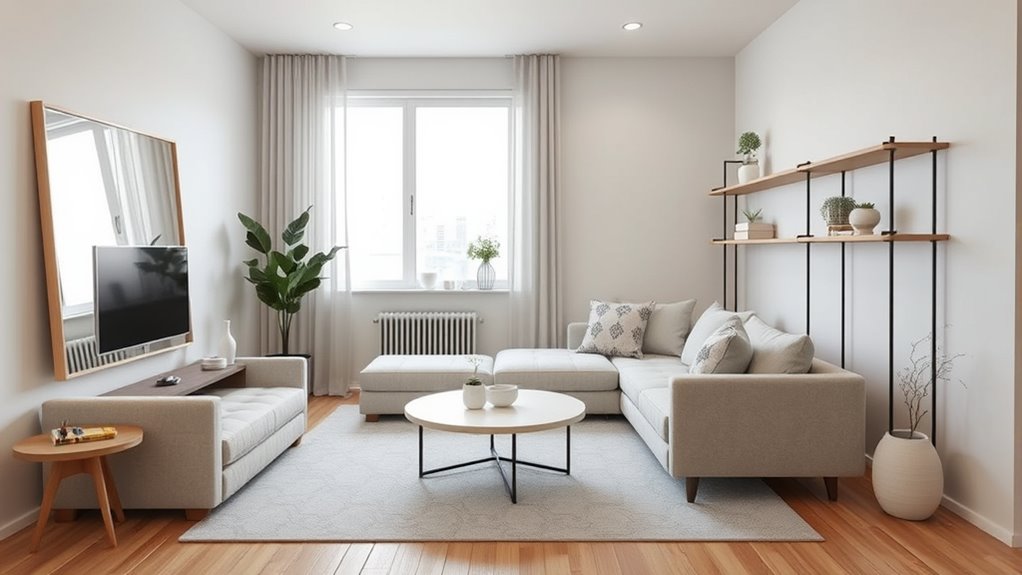
To create a sense of space in a small room, arrange your furniture away from the walls for a more open layout. Use area rugs to define different zones while keeping the flow intact. Balancing your arrangement with smaller pieces can enhance the room’s functionality without overwhelming it. Additionally, consider incorporating multifunctional furniture to save space and improve usability. Utilizing calming color schemes can further amplify the perception of space, making the room feel more expansive and inviting. For added charm, you might consider using vintage furniture that complements the overall aesthetic while enhancing the room’s character. Creating a clutter-free space is essential for ensuring that your small room feels open and serene.
Floating Furniture Arrangement
Arranging your furniture in a floating layout can transform a small room by enhancing its sense of space and flow. Instead of pushing all your pieces against the walls, try pulling them into the room. This floating furniture arrangement creates an open layout that makes the space feel more spacious.
Use low-profile furniture to maintain visibility and prevent a cramped atmosphere. Calming decor can also enhance the overall ambiance, making the room feel even more inviting. Additionally, incorporating natural elements can bring warmth and texture to the space. Experimenting with different layouts can help discover your unique design preferences, ensuring better movement and an airy environment.
You can also use area rugs to subtly define spaces within the room, adding structure without physical barriers. By thoughtfully arranging your pieces, you’ll maximize the room’s potential and create an inviting, functional living area. Additionally, consider incorporating moisture-resistant materials to enhance durability and maintain a fresh atmosphere in your small room.
Define Zones With Rugs
Rugs can work wonders in defining zones within a small room, creating distinct areas for various activities without the need for walls or partitions.
To maximize your space, choose rugs that are proportionate to your furniture layout. A rug that’s too small can make the area feel disjointed, while a properly sized one anchors the furniture. Balanced designs promote harmony in decor, ensuring that each zone feels intentional. Incorporating mindfulness practices in your decluttering process can also aid in selecting rugs that enhance the room’s overall flow. Additionally, selecting rugs made from salvaged materials can contribute to a more sustainable living environment.
Position your rugs strategically, placing the front legs of sofas and chairs on them to create a cohesive look. Layering rugs can also add depth and interest, maintaining an open and airy feel. Opt for lighter colors or subtle patterns that complement your overall color scheme, ensuring your small room feels spacious and inviting. Additionally, incorporating cozy textiles can enhance the overall comfort and style of your space.
Balance With Small Pieces
Creating distinct zones with rugs can set the stage for how you arrange your furniture. To achieve balance in your small room, opt for several small pieces instead of a single large item. This approach prevents a cramped feel and enhances the overall design. Additionally, using seasonal variations can inspire fresh decor choices that complement your small space.
Arranging your furniture away from the walls promotes flow, making the space feel more expansive. Choose sleek, lightweight pieces that match the room’s proportions, contributing to a harmonious look. Incorporating functional design elements can further enhance the usability of the space while maintaining an aesthetic appeal. Additionally, ensuring proper airflow around the unit can help maintain a fresh atmosphere in your small room.
Clear pathways by avoiding bulky furniture in walkways, ensuring smooth navigation and a more open atmosphere. By thoughtfully arranging your small furniture and defining zones, you can create a light and airy environment that maximizes the perception of space in your room. Incorporating scratching posts can also help maintain a tidy appearance by redirecting your cat’s natural instinct to scratch.
Reduce Clutter

To make your small room feel more spacious, you should tackle clutter head-on. Reducing clutter is essential to create a sense of openness. An overloaded space can feel cramped and uninviting, so regularly assess your belongings and remove unnecessary items.
Keep decorative accents to a minimum to maintain a clean and organized appearance; this prevents the room from feeling visually chaotic. Additionally, maintaining breathing room between furniture pieces allows for smoother movement and helps the area feel airy. Embracing everyday materials for your decor can also add unique flair without overwhelming the space.
Opt for solid color fabrics in furniture and decor to add texture without overwhelming the space. Limiting excessive patterns will also help you avoid a cluttered look, making your room feel larger and more inviting. Furthermore, having a clear plan for estate planning can help you manage belongings effectively, ensuring that cherished items are preserved without contributing to clutter.
Add Mirrors
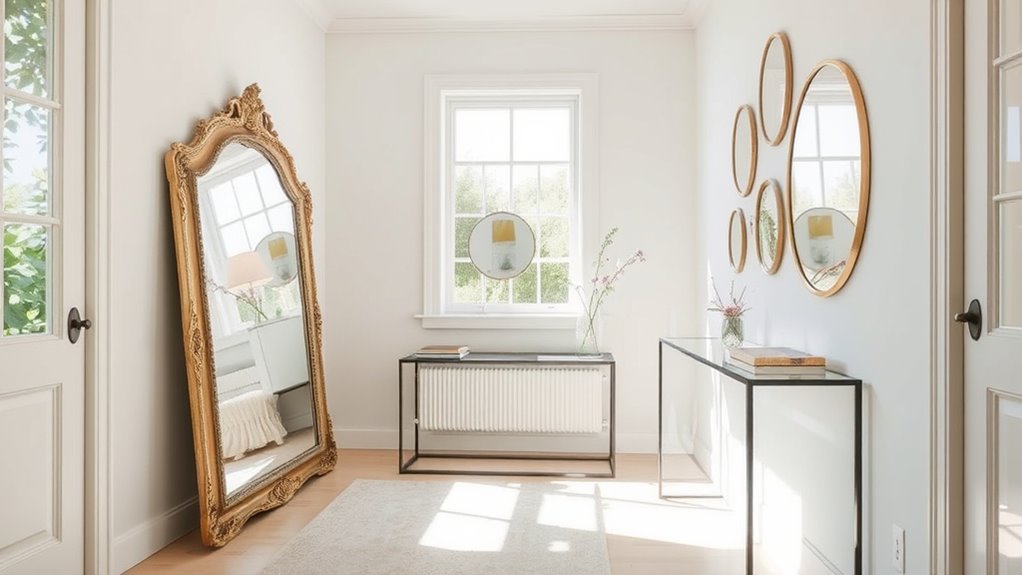
Adding mirrors can dramatically transform the perception of space in a small room. When used wisely, they can create an illusion of depth and openness by reflecting light and views.
Incorporating mirrors can significantly enhance the feeling of space in small rooms by reflecting light and creating depth.
Here are some tips to maximize their impact:
- Position mirrors opposite windows to capture and amplify natural light.
- Opt for large mirrors that can be leaned or hung, avoiding clutter from multiple small ones.
- Choose simple wall-mounted mirrors for a clean and spacious look.
- Use mirrors to add visual interest without overwhelming the space.
- Experiment with different placements to find the best arrangement for your small room.
Emphasize Vertical Space
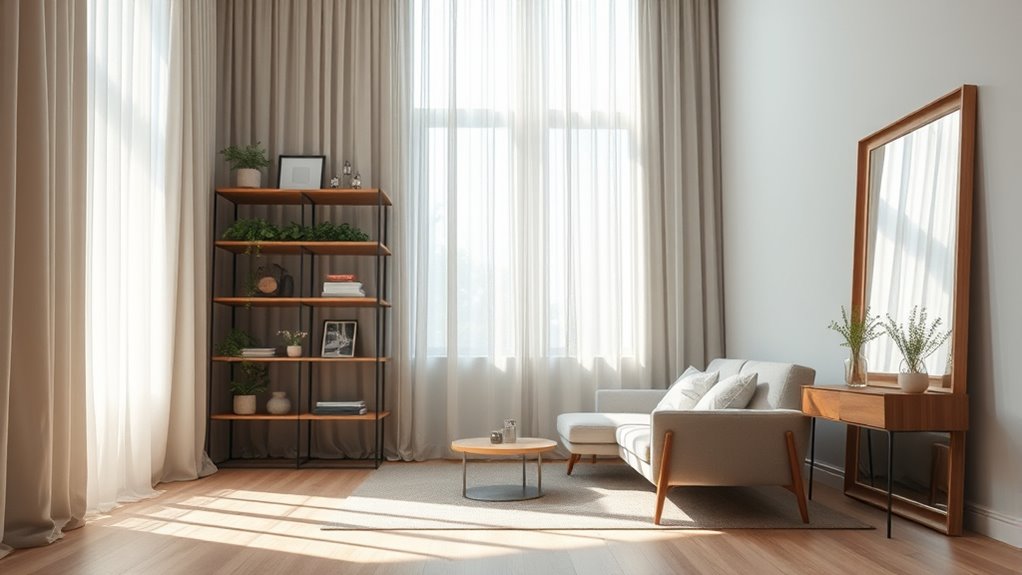
While you may feel limited by the size of your room, emphasizing vertical space can effectively create an illusion of height and openness. Incorporate tall bookshelves or vertical storage solutions to draw the eye upward, making the room feel larger.
Installing vertical shiplap or wallpaper with vertical stripes enhances this effect by emphasizing upward movement. Use hanging light fixtures and pendant lights to accentuate the ceiling height, further contributing to the sense of spaciousness.
Arrange artwork and decor higher on the walls to create an optical illusion of taller walls. Finally, add tall plants or decorative elements to boost the perception of vertical space, enhancing the overall openness of your room.
Choose Multi-Functional Furniture
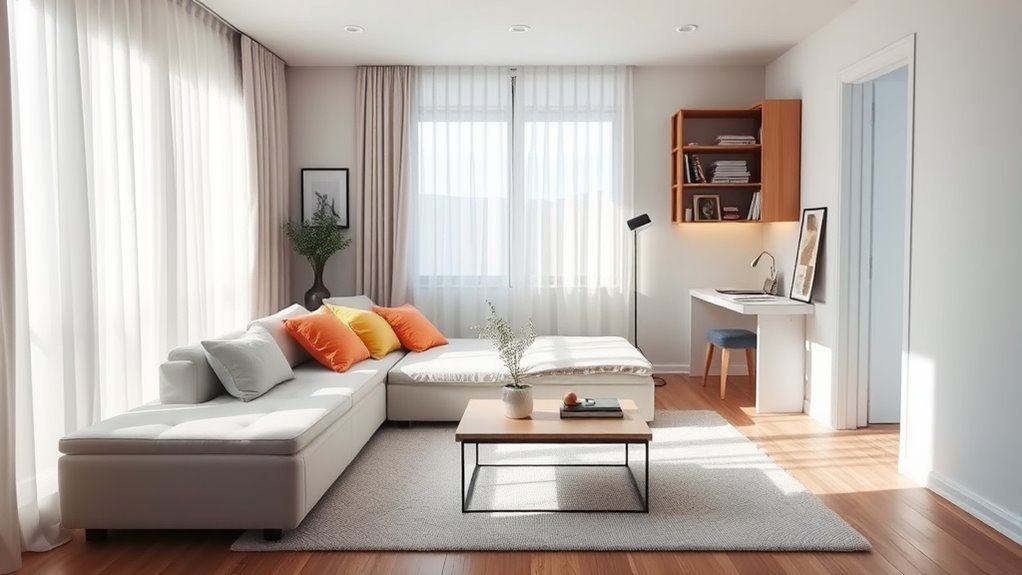
Emphasizing vertical space sets the stage for making the most of your small room, but choosing multi-functional furniture takes it a step further.
By incorporating pieces that maximize utility, you’ll create a small space feel that’s both functional and open. Here are some ideas to contemplate:
- Storage ottomans for seating and organization
- Coffee tables that double as storage units for a streamlined appearance
- Extendable dining tables to accommodate guests without taking up extra space
- Wall beds or foldable desks to free up floor space during the day
- Benches or beds with built-in storage to keep belongings organized and out of sight
With these choices, you can truly make a room look bigger while maintaining style and practicality in petite spaces.
Frequently Asked Questions
How Do Interior Designers Make Small Rooms Look Bigger?
Interior designers make small rooms look bigger by using light, neutral color palettes that reflect light and create an airy feel.
They strategically place mirrors to bounce natural light around, enhancing depth. Multi-functional furniture helps you minimize clutter while maximizing usability.
Incorporating vertical elements draws the eye upward, giving a sense of height. Keeping your space decluttered and organized is essential, so regularly assess your belongings to maintain an open atmosphere.
How Do You Make a Small Room Look Luxury?
To make your small room look luxurious, incorporate high-quality materials like silk or velvet in your furniture and accents.
Stick to a soft, monochromatic color scheme to create an elegant feel.
Choose statement pieces, like oversized art or an eye-catching chandelier, as focal points.
Embrace minimalism with multi-functional furniture to reduce clutter.
Finally, use mirrors strategically to reflect light and enhance the sense of space, adding to the room’s upscale ambiance.
What Pattern Makes a Small Room Look Bigger?
Did you know that using vertical stripes can increase the perception of a room’s height by up to 20%?
For a small room, opting for bold patterns like large-scale wallpaper can create depth and visual interest.
However, it’s essential to balance these designs with solid colors to keep the space from feeling cramped.
How Do You Make a Small Room Look Bigger With Art?
To make a small room look bigger with art, choose oversized pieces that draw the eye and create a focal point.
Hang artwork at eye level or higher to emphasize verticality, which makes the space feel taller.
Opt for a single large piece instead of multiple smaller ones to reduce clutter.
Light, airy colors or abstract designs keep the atmosphere open, and mirrors can reflect light, enhancing the illusion of depth in the room.
Conclusion
By incorporating these designer tricks, you can transform your small room into an inviting oasis that feels more spacious. Remember, a well-placed mirror can reflect not just light, but also your creativity. Embrace light colors, strategic furniture arrangements, and multi-functional pieces to create harmony. With a little effort, your cozy space can expand, making it feel like a refreshing change instead of a confined box. Start today, and watch your small room flourish!
